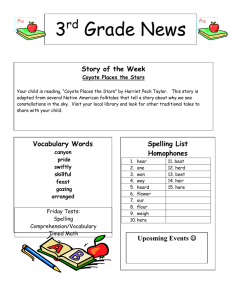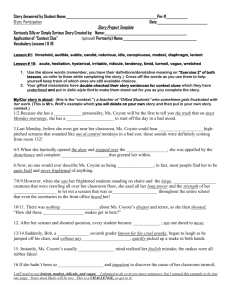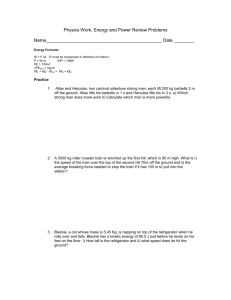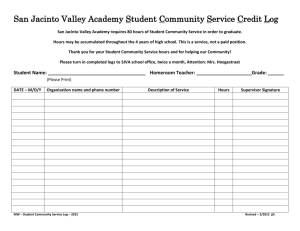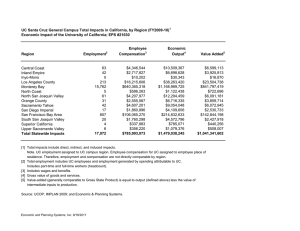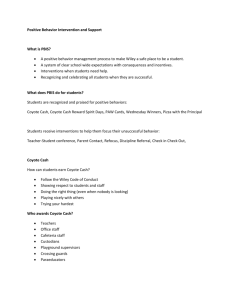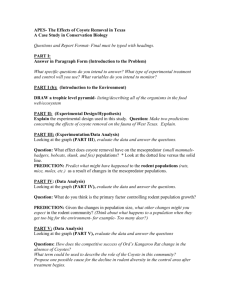Beyond the Environment: Socio- Economic Sustainability & Meaningful
advertisement
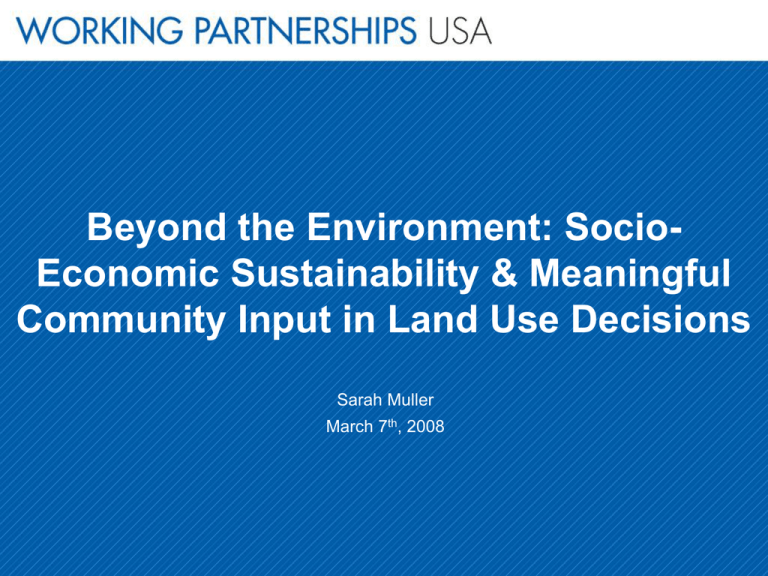
Beyond the Environment: SocioEconomic Sustainability & Meaningful Community Input in Land Use Decisions Sarah Muller March 7th, 2008 Outline • Overview • Challenges Facing Local Government • Community Impact Reports • Case Study: San Jose Cost Benefit Analysis • Large Scale Land Use Decisions • Case Study: Coyote Valley • Lessons Learned Beyond the Environment: SLIDE 2 Challenges Facing Local Government • Limited government resources: • • Cities and Counties across the country are facing structural budget deficits requiring ongoing cuts to needed services and staff Growing community needs: • Affordable housing School improvements • Additional park space Neighborhood services • Access to health care services Beyond the Environment: SLIDE 3 Opportunities for Local Government • Leverage: Economic development • Set local standards on what should be built and where • Create a vision/platform for future development • Set standards regarding opportunities for public involvement Beyond the Environment SLIDE 4 Community Impact Reports • Community Impact Reports: project level analysis that provides additional information on how a proposed project will positively or negatively impact a community • CIR’s often include information on: • Impact on the local housing market • Fiscal impact to the city (i.e. will new revenue be generated) • Impact on parks and city services • Impact on jobs Beyond the Environment SLIDE 5 Case Study: San Jose Cost Benefit Analysis • To be applied to all projects that receive more than $1 million in public subsidies. • Projects must include the following analysis: • Net fiscal impact: A calculation of tax revenues generated by the subsidy minus tax revenues lost. • Net job impact: number of jobs generated from the project • Housing impact: number of housing units constructed or demolished • Neighborhood impacts: including services such as parks, community centers and libraries • Community Input: All information regarding the proposed project must be available to the public 30 days before a City Council vote on the project. Beyond the Environment : SLIDE 6 Large Scale Land Use Decisions • Local government can also leverage social and environmental standards on large scale land use decisions • Such large scale land use planning efforts can include: • General/ Comprehensive Plan updates • Visioning process • Specific Plan • Planning for transit development Beyond the Environment: SLIDE 7 Overview of Coyote Valley Project • Coyote Valley: 7,000 acres • Approximately 3,500 acres are reserved as permanent open space • City of San Jose’s goal: 50,000 jobs and 25,000 housing units • When complete, Coyote Valley will have approximately 80,000 residents Beyond the Environment: SLIDE 8 Social and Environmental Equity Goals • • Affordable Housing • 20% affordability (5,000 units) • 3,000 units will go to households earning at or below $40,000/yr Health Care Services • Require that the City include two health care clinics in the Specific Plan and that funding for construction be included in the overall infrastructure cost of the project Beyond the Environment SLIDE 9 Social and Environmental Equity Goals • • Parks/ Open Space • Ensure that Coyote Valley has adequate park spaces for all community members • Open space preservation (3,500 acres) Neighborhood Design/ Transportation • Encourage mixed-use high density development • Provide a comprehensive public transit system • Creates an urban center that promotes commercial activity within the urban core and not along the freeway Beyond the Environment : SLIDE 10 Lessons Learned • Local governments and city staff and community members need to think creatively about how they can use economic development to leverage a improvements all residents in their community • Community Impact Reports and large scale planning processes can provide substantial benefits to local communities without impacting city finances or creating disincentives for developers Beyond the Environement: SLIDE 11
